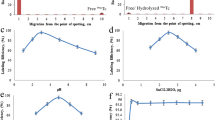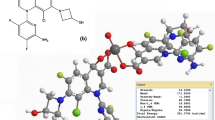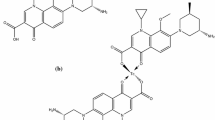Abstract
Synthesis of the 99mTc(CO)3–trovafloxacin dithiocarbamate (99mTc(CO)3–TVND) complex and biological characterization in artificially Staphylococcus aureus (S. aureus) infected rats model was assessed. The suitability of the complex was evaluated and compared with 99mTcN–TVND, in terms of radiochemical immovability in saline, in vitro permanence in serum, in vitro binding with S. aureus and biodistribution in Male Sprague-Dawley rats (MSDR). After 30 min of the reconstitution both the complexes showed maximum radiochemical stabilities in saline and remain more than 90% stable up to 120 min. However the 99mTc(CO)3–TVND showed to some extent higher stability than 99mTcN–TVND complex. In serum 1.75% less de-tagging was observed than 99mTcN–TVND complex. Both the complexes showed saturated in vitro binding with S. aureus and no significant difference were observed between the uptakes. Six fold uptakes were noted in the infected muscle as compared to the inflamed and normal muscles of the MDSR. The uptake of the 99mTc(CO)3–TVND in infected muscle of the MSDR was 2.25% high as compared to the 99mTcN–TVND complex. Based on radiochemical stabilities in saline, serum, in vitro binding with MRSA and significantly higher uptake in the infected muscle, we recommend both the complexes for in vivo investigation of the MRSA infection in human.
Similar content being viewed by others
Avoid common mistakes on your manuscript.
Introduction
Scintigraphic localization of infection and its discrimination from inflammation at early stages through technetium-99m (99mTc) labeled radiopharmaceuticals has solved the serious problem of the clinicians [1, 2]. The existing [3–15] and our reported [16–23] radiopharmaceuticals for infection localization had shown promising results in the detection of bacterial infections caused by various pathogens. The encouraging results support our effort to search for more specific radiopharmaceuticals for infection imaging.
Recently it has been reported that quinolones have shown strong antibiotic activity against a variety of pathogens e.g. Staphylococcus aureus (S. aureus), Mycobacterium, Legionella pneumophila (L. pneumophila), Enterococcus faecium (E. faecium) and Escherichia coli (E. coli). Trovafloxacin (TVN) (Fig. 1a), {1,5,6-α-7-(6-amino-3-azabicyclo[3.1.0]hex-3-yl)-1-(2,4-difluorophenyl) -6-fluoro-1,4-dihydro-4-oxo-1,8-naphthyridine-3-carboyilic acid} is one of the novel antibiotic of quinolones group that exhibit broad spectrum antibacterial activity against S. aureus, E. faecium and L. pneumophila [24, 25].
The complexation of biomolecules with 99mTc using [99mTc(CO)3(H2O)3]+ precursor have been recently explored and found it as a suitable radiolabeling procedure [22, 23]. In continuation to our ongoing investigations, the aim of the present study was to exploit and compare the radiolabeling of trovafloxacin dithiocarbamate (TVND) with 99mTc using the [99mTc(CO)3(H2O)3]+ precursor and [99mTc≡N]+ core. The possibility of the 99mTc(CO)3–TVND complex as potential S. aureus infection radiotracer was assessed in Male Sprague-Dawley rats (MSDR) and compared with 99mTcN–TVND complex. The effectiveness of the complex was evaluated in terms of in vitro immovability in normal saline and serum, in vitro binding with S. aureus, and biodistribution in MDSR.
Experimental
Materials
Trovafloxacin (TVN) (Pfizer Inc. New York, USA), TLC (Merk), succinic dihydrazide (SDH), propylenediamine tetra-acetic acid (PDTA) and all the other chemicals and solvents of analytical grade (Sigma). RP-HPLC (Shimadzu, Japan), well counter, scalar count rate meter (Ludlum, USA), Dose calibrator (Capintech, USA) and Gamma camera GKS-1000 (GEADE Nuclearmedizine system, Germany).
Method
Preparation and radiocomplexation of trovafloxacin dithocarbamate
Trovafloxacin (TVN) was converted to trovafloxacin dithocarbamate (TVND) by reacting TVN with equimolar amount of carbon disulfide (CS2) in the presence of sodium hydroxide and tetrahydrofuran (THF) using the reported procedure [23]. The radiocomplexation of the TVND with 99mTc using [99mTc(OH2)3(CO)3]+ precursor was investigated by adding 0.5 mL (1–2 mCi) of sodium pertechnetate (Na99mTcO4 −) and 0.1 mol/mL HCL solution to the Iso-link kit and incubated for 15 min. After that 2 mg liquefied TVND was added to the kit through a sterilized syringe followed by incubation at room temperature for 15 min.
Partition coefficient (P)
Partition coefficient of the 99mTc(CO)3–TVND complex was evaluated and compared with 99mTcN–TVND complex adopting the process described earlier [23]. Briefly, the 99mTc(CO)3–TVND complex, octanol and phosphate buffer (PB) in equals amounts were vortexed for 5 min at room temperature. Then the reaction mixture was centrifuged at 5000 rpm/min for 15 min. Subsequently, aliquots (0.1 mL) were haggard at different intervals and counted using well counter interface with scalar count rate meter. The following formula was used for the calculation of the P. The same process was repeated for P calculation of the 99mTcN–TVND complex.
Radiochemical purity (RCP) determination and characterization
In normal saline the RCP values of the 99mTc(CO)3–TVND complex was determined by using HPLC method as described earlier [23]. Briefly, 10 μL aliquots of the freshly prepared 99mTc(CO)3–TVND complex were withdrawn from vial and injected into the Shimadzu SCL-10 AVP system equipped with SDP-10 AVP UV detector operating at 254 nm, Packard 500 TR series flow scintillation analyzer, binary pump and online degasser and C-18 (4.6 × 150 mm) column. Water:methanol (W:M) was employed as the mobile phase and a flow rate of 1 mL/min was applied for 15 min. The mobile phase (W:M) used was; for 0–3 min (100:00), 3–5 min (60:40), 5–8 min (55:45), 8–10 (25:75), 10–13 (00:100) and 13–15 (100:100). During the elution (1–15 min) the radio-fractions collected were measured separately using the single gamma rays detecting well counter interface with scalar count rate meter. The same process was repeated for the 99mTcN–TVND complex.
In vitro stability in serum
In vitro stability of the 99mTc(CO)3–TVND complex was investigated in serum at 37 °C using the TLC procedure. 1.8 mL of the serum was incubated at 37 °C with 99mTc(CO)3–TVND complex. Thereafter, aliquots at 0, 2, 4, 6, 8, 10, 12, 14 and 16 h of incubation were withdrawn and executed for percent stability on TLC strip. The strips were than developed in saline and CH2Cl2:CH3OH (9:1) (v/v). Subsequently, the developed strips were divided into two equal parts and measured for percent in vitro stability using single well gamma rays detecting well counter interface with scalar count rate meter. The same process was repeated for the earlier reported 99mTcN–TVND complex [23].
In vitro binding with MRSA
In vitro binding of the 99mTc(CO)3–TVND complex with S. aureus was assessed using the reported procedure [26]. Briefly, the 99mTc(CO)3–TVND complex (10 MBq) was poured into a sterilized test tube having 0.1 mL sodium phosphate buffer (Na-PB) followed by addition of 0.8 mL (50%, v/v) 0.01 M acetic acid containing approximately 1 × 108 colony forming units (CFU) of S. aureus and incubation at 4 °C for 1 h with a final pH 5. The reaction mixture was centrifuged at 2000 rpm for 10 min. Thereafter, the supernatant was removed and the bacterial pellets were resuspended in 2 mL Na-BP. The blend was again centrifuged at 2000 rpm for 10 min. Thereafter, the pellets were measured for percent in vitro uptake.
In vivo percent uptake in MRSA infected MSDR
Healthy Male Sprague-Dawley Rats (MSDR) (weight, 180–220 g) were randomly selected and divided into two groups (A and B) with seven rats in each group for the determination of biodistribution of the 99mTc(CO)3–TVND complex. Rats of group A and B were intramuscularly (I.M.) injected with 0.2 mL sterile turpentine oil into the right thigh and 0.2 mL of living strain of S. aureus (containing approximately 1 × 108 CFU) to the left thigh. After 18 h, 0.5 mL (18.5 MBq) of the 99mTc(CO)3–TVND complex through ear vein was injected to the rats of group A and B. Thereafter, all the rats were killed as per rule stipulated in the manual of Nuclear Medicine Research Laboratory (NMRL) University of Peshawar Part-I and II. The percent absorbed dose per gram in blood, liver, spleen, stomach, intestine, kidney, infected muscle, inflamed and normal muscle was measured with single well gamma rays detecting counter interface with scalar count rate meter. The biodistribution profile of the 99mTc(CO)3–TVND complex was compared with the 99mTcN–TVND complex.
Results and discussion
Chemistry and geometry
Trovafloxacin dithiocarbamate (TVND) Fig. 1b was obtained in good yield using trovafloxacin (Fig. 1a) as the starting material and its radiocomplexation with 99mTc using the [99mTc(CO)3(H2O)3]+ precursor to give the 99mTc(CO)3–TVND complex as shown in Fig. 1c. The water molecule in the radiocomplexation was rapidly displaced from the [99mTc(CO)3(H2O)3]+ precursor by the TVND. The 99mTc(CO)3–TVND radiocomplex in a high yield was recovered with a 98.75 ± 0.15% radiochemical purity. The proposed structure of the 99mTc(CO)3–TVND radiocomplex (Fig. 1c) will have a square planner bipyramidal geometry with metal:ligand ratio of 2:1.
Partition coefficient (P)
The participation coefficient (P) values of the 99mTc(CO)3–TVND and 99mTcN–TVND complexes observed were 0.44 ± 0.01 and 1.08 ± 0.02 respectively. Both the P values of radiocomplexes suggested lipophilic nature.
HPLC radio-characterization
Two radio-peaks at retention time (RT) 3.1 and at 11.2 min were observed in the HPLC radio-chromatogram of the 99mTc(CO)3–TVND complex. The radio-peak at 11.2 represents the yield of the 99mTc(CO)3–TVND complex. A similar HPLC radio-chromatogram was shown by the 99mTcN–TVND complex with two radio-peaks at RT 3.9 and 12.6 min [R]. The radio-peak at RT 3.9 min correspond to [99mTcN]2+ intermediate and 12.6 min to the 99mTcN–TVND complex Fig. 2.
Radiochemical purity (RCP)
A stable in vitro radiochemical purity yields were observed for both (99mTc(CO)3–TVND and 99mTcN–TVND) radiocomplexes at different intervals after reconstitution as given in Fig. 3. It was observed that the RCP values of both the radiocomplexes decreased with time. The RCP values determined after 30 min of the preparation were 97.90 ± 0.22% (n = 9) and 98.75 ± 0.15% (n = 9) respectively. After 240 min the RCP values went down to 91.40 ± 0.25% (n = 9) and 92.10 ± 0.19% (n = 9) respectively. Insignificantly higher values of the RCP were observed for the complex synthesized through [99mTc(CO)3(H2O)3]+ precursor. After 240 min no significant difference was observed between the RCP values of both the radiocomplexes.
In vitro stability in serum
Both the radiocomplexes showed in vitro stability in serum at 37 °C as shown in Fig. 4. The stability of both the radiocomplexes marginally went down from 96.50 ± 0.40 to 80.25 ± 0.42% and 97.00 ± 0.35 to 82.50 ± 0.30% respectively, after 16 h of incubation.
In vitro binding with MRSA
Both the radiocomplexes showed saturated in vitro binding with S. aureus as shown in Fig. 5. An insignificantly higher uptake was noted with 99mTc(CO)3–TVND as compared to the 99mTcN–TVND radiocomplex.
In vivo percent uptake in MRSA infected MSDR
Tables 1 and 2, gives the percent absorbed dose of the 99mTc(CO)3–TVND and 99mTcN–TVND radiocomplex respectively, per gram in blood, liver, spleen, stomach, intestine, kidney, infected muscle, inflamed and normal muscle of the healthy Male Sprague-Dawley Rats (MSDR) artificially infected with living and heat killed S. aureus. The activity of both the complexes in blood (per gram) in the beginning was 20.50 ± 0.18 and 22.00 ± 0.35% respectively. These high activities markedly decreased to 3.50 ± 0.15 and 3.85 ± 0.40% within 120 min of the I.V. administration. In liver, spleen, stomach and intestines a similar trailing profile was noted. However in kidneys a reverse profile was noted where the activities in the beginning were 10.50 ± 0.16 and 9.50 ± 0.37% which increased to 23.25 ± 0.16 and 22.85 ± 0.35% within 120 min respectively. Both the complexes showed significantly higher uptake in the S. aureus infected muscle of the MSDR as compared to the inflamed and normal muscles. The appearance of activity of both the radiocomplex in urinary system and disappearance from circulatory system established the usual path of excretion.
The ratios of the uptake of both the complexes (infected to normal muscle, infected to inflamed muscle and inflamed to normal muscle) are shown in Fig. 6. In both the complexes almost six and five fold uptake was noted in the infected (target organ) to inflamed or normal muscles (non-target organ) respectively.
Conclusion
Synthesis of the 99mTc(CO)3–TVND radiocomplex and biological characterization in S. aureus infected MSDR was assessed. The aptness of the complex was evaluated in terms of radiochemical immovability in saline, in vitro permanence in serum, in vitro binding with MRSA and biodistribution and compared with 99mTcN–TVND. Both the radiocomplexes shown comparably similar results but the high target to non-target ratios posed the 99mTc(CO)3–TVND radiocomplex as a better S. aureus infection radiotracer than 99mTcN–TVND radiocomplex.
References
Gallagher H, Ramsay SC, Barnes J, Maggs J, Cassidy N, Ketheesan N (2006) Neutrophil labeling with [99mTc]-technetium stannous colloid is complement receptor 3-mediated and increases the neutrophil priming response to lipopolysaccharide. Nucl Med Biol 33:433
Basu S, Chryssikos T, Moghadam-Kia S, Zhuang H, Torigian DA, Alvai A (2009) Positron Emission Tomography as a diagnostic tool in infection: present role and future possibilities. Semin Nucl Med 39:36
Chattopadhyay S, Das SS, Chandra S, De K, Mishra M, Sarkar BR, Sinha S, Ganguly S (2010) Synthesis and evaluation of 99mTc-moxifloxacin, a potential infection specific imaging agent. Appl Radiat Isotopes 68:314
Motaleb MA (2007) Preparation of 99mTc-cefoperazone complex, a novel agent for detecting sites of infection. J Radioanal Nucl Chem 272:167
Motaleb MA (2007) Preparation and biodistribution of 99mTc-lomefloxacin and 99mTc-olfloxacin complex. J Radioanal Nucl Chem 272:95
Zhang J, Guo H, Zhang S, Lin Y, Wang X (2008) Synthesis and biodistribution of a novel 99mTcN complex of ciprofloxacin dithiocarbamate as a potential agent for infection imaging. Bioorg Med Chem Lett 18:51
Roohi S, Mushtaq A, Jehangir M, Ashfaq MS (2006) Synthesis, quality control and biodistribution of 99mTc-Kanamycin. J Radioanal Nucl Chem 267:561
Oh SJ, Ryu J, Shin JW, Yoon EJ, Ha H, Cheon JH, Lee HK (2002) Synthesis of 99mTc-ciprofloxacin by different methods and its biodistribution. Appl Radiat Isot 57:193
El-Gany EA, El-Kolaly MT, Amine AM, El-Sayed AS, Abdel-Gelil F (2005) Synthesis of 99mTc-pefloxacin: a new targeting agent for infectious foci. J Radioanal Nucl Chem 266:131
Motaleb MA (2009) Preparation, quality control and stability of 99mTc-sparafloxacin complex, a novel agent for detecting sites of infection. J Labelled Comp Radiopharm 52:415
Xia J, Wang Y, Yu J, Li S, Tang L, Zheng M, Liu X, Li G, Cheng D, Liang S, Yin D (2008) Synthesis, in vitro and in vivo behavior of 188Re(I)-tricarbonyl complexes for the future functionalization of biomolecules. J Radioanal Nucl Chem 275:325
Zhang J, Wang X, Jin C (2007) Synthesis and biodistribution of the 99mTc(CO)3-DEDT complex as a potential new radiopharmaceutical for brain imaging. J Radioanal Nucl Chem 272:91
Djokic DD, Jankovic DL, Stamenkovic LL, Pirmettis I (2004) Chemical and biological evaluation of 99mTc (CO)3 and 99mTc complexes of some IDA derivatives. J Radioanal Nucl Chem 260:471
Xia J, Long S, Yu J, Wang Y, Cao Z (2009) Pyridyl derivatives provide new pathways for labeling protein with fac-[188Re(CO)3(H2O)3]+. J Radioanal Nucl Chem 281:493
Zhang JB, Wang XB, Jin C (2006) Synthesis of 99mTc(CO)3-NOET via [99mTc(OH2)3(CO)3]+ precursor and comparative biological studies with 99mTcN-NOET. J Radioanal Nucl Chem 269:227
Qaiser SS, Khan AU, Khan MR (2010) Synthesis, biodistribution and evaluation of 99mTc-Sitafloxacin kit: a novel infection imaging agent. J Radioanal Nucl Chem 284:189
Shah SQ, Khan AU, Khan MR (2010) Radiosynthesis of 99mTc-nitrifuratonin a novel radiotracer for in vivo imaging of Escherichia coli infection. J Radioanal Nucl Chem. doi:10.1007/s10967-010-0697-z
Shah SQ, Khan AU, Khan MR (2010) Radiosynthesis and biodistribution of 99mTc-rifampicin: a novel radiotracer for in vivo infection imaging. Appl Radiat Isot 68:2255
Shah SQ, Khan AU, Khan MR (2010) 99mTc-Novobiocin: a novel radiotracer for infection imaging. Radiochim Acta (in press)
Shah SQ, Khan AU, Khan MR (2010) Radiosynthesis, biodistribution and scintigraphy of the 99mTc-Teicoplanin complex in artificially infected animal models. J Labelled Comp Radiopharm. doi:10.1002/jlcr.1834
Shah SQ, Khan AU, Khan MR (2010) Radiosynthesis and biological evaluation of 99mTcN-sitafloxacin dithiocarbamate as potential radiotracer for Staphylococcus aureus infection. J Radioanal Nucl Chem. doi:10.1007/s10967-010-0833-9
Shah SQ, Khan AU, Khan MR (2010) Radiosynthesis and biological evolution of 99mTc(CO)3-sitafloxacin dithiocarbamate complex: a promising Staphylococcus aureus infection radiotracer. J Radioanal Nucl Chem. doi:10.1007/s10967-010-0880-2
Shah SQ, Khan MR (2010) Radiocomplexation and biological characterization of the 99mTcN-Trovafloxacin dithiocarbamate: a novel methicillin-resistant Staphylococcus aureus infection imaging agent. J Radioanal Nucl Chem. doi:10.1007/s10967-010-0903-z
Ocaña JA, Callejón M, Barragán FJ (2001) Determination of trovafloxacin in human serum by time resolved terbium-sensitised luminescence. Eur J Pharm Sci 13:297
Hsiao CJ, Younis H, Boelsterli UA (2010) Trovafloxacin, a fluoroquinolone antibiotic with hepatotoxic potential, causes mitochondrial peroxynitrite stress in a mouse model of underlying mitochondrial dysfunction. Chem Biol Interact 188:204
Welling MM, Paulusma-Annema A, Batler HS, Pauwels EKJ, Nibbering PH (2000) Technetium-99m labelled antimicrobial peptides discriminate between bacterial infections and sterile inflammations. Eur J Nucl Med 27:292
Author information
Authors and Affiliations
Corresponding author
Rights and permissions
About this article
Cite this article
Shah, S.Q., Khan, M.R. Synthesis of the 99mTc(CO)3–trovafloxacin dithiocarbamate complex and biological characterization in artificially methicillin-resistant Staphylococcus aureus infected rats model. J Radioanal Nucl Chem 288, 297–302 (2011). https://doi.org/10.1007/s10967-010-0914-9
Received:
Published:
Issue Date:
DOI: https://doi.org/10.1007/s10967-010-0914-9










